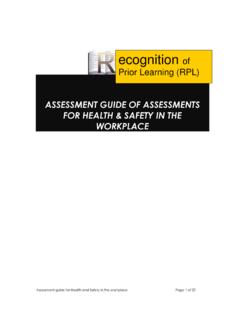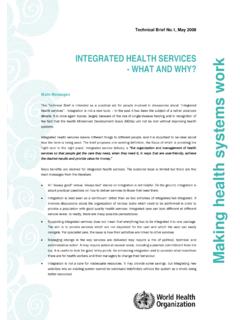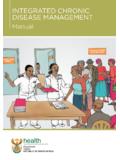Transcription of INTEGRATED HEALTH SERVICES – WHAT AND WHY
1 Technical Brief , 2008 INTEGRATED HEALTH SERVICES what AND WHY ?Main MessagesThis Technical Brief is intended as a practical aid for people involved in discussions about INTEGRATED HEALTH SERVICES . Integration is not a new topic in the past it has been the subject of a rather polarized debate. It is once again a topical issue, largely because of the rise of single-disease funding and recognition of the fact that the HEALTH Millennium Development Goals (MDGs) will not be met without improving HEALTH systems. INTEGRATED HEALTH SERVICES means different things to different people it is important to be clear about how the term is being used.
2 Six common uses of the term are described in this Brief. Integration is best seen as a continuum rather than as two extremes of INTEGRATED /not INTEGRATED . Integration is about the organization of various tasks which need to be performed in order to provide a population with good quality HEALTH overall working definition of INTEGRATED service delivery is The management and delivery of HEALTH SERVICES so that clients receive a continuum of preventive and curative SERVICES , according to their needs over time and across different levels of the HEALTH system. The evidence base about integration is limited, though a systematic review was published in 2007 (15).
3 We have learned 3 important lessons : Supporting INTEGRATED SERVICES does not mean that everything has to be INTEGRATED into one package. In reality, there are many possible permutations. Integration isn t a cure for inadequate resources. There are more examples of policies in favour of INTEGRATED SERVICES than examples of actual implementation. Managing change may require action at several levels. It requires engagement of HEALTH workers and managers, plus a sustained commitment from senior management and HEALTH systems workIntroductionThis Technical Brief is intended as a practical aid for people involved in discussions about INTEGRATED HEALTH SERVICES .
4 The term INTEGRATED HEALTH SERVICES has several usages and can refer to a number of different HEALTH service issues. This Brief aims to demonstrate both the importance of clarity and the fact that integra-tion is an important and topical issue. The Brief outlines the various definitions of INTEGRATED HEALTH service and proposes one overall working definition. It then briefly describes key questions around integration is it a good thing? How is it achieved? In the past, discussions about integration have been rather polarized this Brief aims to show that integration is best seen as a continuum and is about the organization of various tasks which need to be performed in order to provide a population with good quality HEALTH SERVICES .
5 The length of this Brief obviously means that it cannot describe the full complexities of the subject references are provided for interested readers who want to explore the subject in more depth. Context We need a comprehensive, INTEGRATED approach to service delivery. We need to fight fragmentation. WHO Director-General, 2007 (1)Why has the Director-General of WHO called so unequivocally for INTEGRATED HEALTH SERVICES ? There are a num-ber of reasons for the current interest in INTEGRATED SERVICES : Recent years have seen a dramatic rise in funding for single-disease or population-group-specific programmes, such as HIV/AIDS, immunizations, malaria and polio eradication.
6 For example, funding for HIV/AIDS as a proportion of total HEALTH Official Development Assistance (ODA) has risen from less than 10% in the 1990s to around 30% currently. (2) There are concerns about potentially adverse effects on less well-funded HEALTH priorities. HEALTH SERVICES face resource constraints. Of particular concern are human resource shortages in low income countries. Available resources have to be used as efficiently as possible. The MDGs with their simultaneous focus on child and maternal HEALTH , HIV/AIDS and malaria have highlighted the fact that some constraints to effective scaled-up service delivery are common to several technical programmes.
7 For example all the HEALTH -related MDGs rely on the existence in a country of a well-functioning workforce of nurses and an efficient pharmaceutical distribution system it thus makes no sense to tackle the three relevant Goals separately. (3, 4)Talk of integration can arouse fears that specialist functions will be compromised. One example is technical supervision: efforts to introduce more INTEGRATED supervision, to reduce demands on local HEALTH workers time and generate economies of scale with limited resources, raise fears about reduced quality of supervision. This fear should be baseless in a properly designed system, but must be addressed: such a system might well include specialist oversight of - for example - surveillance for a package of infectious diseases.
8 The idea of INTEGRATED HEALTH SERVICES is not new. Indeed it was the basis for the focus on primary HEALTH care in the 1980s. For some people this renewed interest is not surprising, as they regard INTEGRATED SERVICES as the most logical way to organize a HEALTH system indeed the only way that does not compromise universal access to a broad range of SERVICES . The current challenge is to be specific about what INTEGRATED SERVICES look like what are the key functions which need to be delivered? 2 | Technical Brief No. 1 Multiple Meanings INTEGRATED HEALTH SERVICES means different things to different people.
9 There are six main usages, but many nuances within these. Inevitably these overlap somewhat, particularly definitions 1 and INTEGRATED is frequently used to refer to a package of preventive and curative HEALTH interventions for a particular population group often (but not always) this group is distinguished by its stage in the life cycle. (5) Examples are the INTEGRATED Management of Childhood Illness (IMCI), INTEGRATED Manage-ment of Pregnancy and Childbirth (IMPAC), INTEGRATED Management of Adolescent and Adult Illness (IMAI) and (not specifically related to life cycle) INTEGRATED Management of Cardiovascular Risk.
10 The aim of this form of integration is for individuals in the target group to receive all appropriate interventions, ideally from the client s perspective at a one-stop shop . This can be very important for example, TB SERVICES need to deal with the fact that many of their clients may be HIV positive; be malnourished, smoke or have diabetes. Key questions under this definition are: exactly what interventions should be packaged together? How are management support systems best organized to service these interventions?12. INTEGRATED HEALTH service can refer to multi-purpose service delivery points a range of SERVICES for a catchment population is provided at one location and under one overall manager.
















